 |
 |
 |
 |
 |
| For more information follow these links. |
|
 |
 |
 |
 |
|
Some activities are compulsory in viticulture: to prepare the soil and choose the grape varieties one wishes to grow, to prune and guide the grapevines’ growth, to avoid diseases and pests and, if necessary, to irrigate the vine. Before planting the vine one should carry out a study of the characteristics of the soil and climate, in order to understand which grape varieties are best suited and what methods are going to be used.
 Soil is a key element when choosing a place to plant the vine, since it is through it that the vine is going to be fed. Therefore, it is necessary to prepare and fertilise the soil before starting the plantation. In order for the grapevine to develop correctly, the soil has to have room for the root to grow. It is important to increase the internal drainage of the land and the ability to retain water in the soil. Besides that, an analysis of the soils should be performed to determine which elements should be deeply buried to create a good nutrient reservoir. Soil is a key element when choosing a place to plant the vine, since it is through it that the vine is going to be fed. Therefore, it is necessary to prepare and fertilise the soil before starting the plantation. In order for the grapevine to develop correctly, the soil has to have room for the root to grow. It is important to increase the internal drainage of the land and the ability to retain water in the soil. Besides that, an analysis of the soils should be performed to determine which elements should be deeply buried to create a good nutrient reservoir.
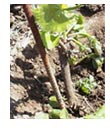 By the end of the 19th Century all Europe was invaded by phylloxera, a wine disease caused by an insect, which has devastated many vines. When trying to fight this fatal disease it was found that the American grapevines were resistant to the insect. From that time onwards one started to graft the grapevines, i.e., to use an American root and a European upper part (this last one determines the fruit produced). Rootstocks should be chosen according to the soil and grape variety. By the end of the 19th Century all Europe was invaded by phylloxera, a wine disease caused by an insect, which has devastated many vines. When trying to fight this fatal disease it was found that the American grapevines were resistant to the insect. From that time onwards one started to graft the grapevines, i.e., to use an American root and a European upper part (this last one determines the fruit produced). Rootstocks should be chosen according to the soil and grape variety.
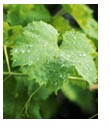 Vitis-vinifera is the most grown grapevine in Portugal. Grape varieties should be selected according to soil, climate and type of wine to be produced. The same grape variety gives rise to completely different wines, depending on the soil and climate, though some aromatic components remain constant independently from those factors. Each demarcated region has recommended grape varieties, which stand out due to their high quality, excellence and local adaptation to the production of wines. Vitis-vinifera is the most grown grapevine in Portugal. Grape varieties should be selected according to soil, climate and type of wine to be produced. The same grape variety gives rise to completely different wines, depending on the soil and climate, though some aromatic components remain constant independently from those factors. Each demarcated region has recommended grape varieties, which stand out due to their high quality, excellence and local adaptation to the production of wines.
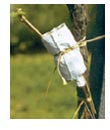 Grafting consists of fitting a European upper part of a plant (leaf, stem, grapes) to an American root (called rootstock), forming one single plant. The graft may be connected through T-budding (using a piece of branch) or chip budding (using a piece of bark with a fissure), but the first one is most commonly used. Grafting should be performed at about 20º-25ºC, because at these temperatures there is a high cellular activity and the plant produces healing elements that help unite the two parts. Nowadays, it is possible to buy “ready” grafts, i.e., grafts ready to be planted. Grafting consists of fitting a European upper part of a plant (leaf, stem, grapes) to an American root (called rootstock), forming one single plant. The graft may be connected through T-budding (using a piece of branch) or chip budding (using a piece of bark with a fissure), but the first one is most commonly used. Grafting should be performed at about 20º-25ºC, because at these temperatures there is a high cellular activity and the plant produces healing elements that help unite the two parts. Nowadays, it is possible to buy “ready” grafts, i.e., grafts ready to be planted.
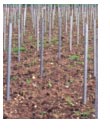 Vine plantation begins between January and March, during vegetative rest. In cold and wet climates, plantation should be done later than in hot and dry ones. Vine training refers to the grapevine distribution in the soil, i.e., the way the vine is distributed in the field and the plant’s development is structured. 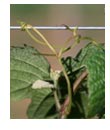 Training is essential for the production of good quality grapes, its main purpose being to provide the best conditions for the development of the plant, in accordance with the surrounding environment. There are traditional and modern ways of training, but they all have the same purpose: to allow sunlight to reach the bunches, which would otherwise be concealed by the grapevine’s leaves.
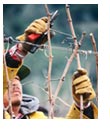 Pruning consists of cutting a piece of the grapevine’s bunches in an attempt to create better production conditions and balance between the plant and its vegetation. Otherwise, the grapevine produces many bunches made up of small, low quality berries. If pruning is done after harvesting, when the grapevine has no leaves, it is called winter pruning: the grapevine is in vegetative rest and pruning is done to prepare the following year’s production. If pruning is performed when the grapevine already has leaves, it is named green pruning. Pruning consists of cutting a piece of the grapevine’s bunches in an attempt to create better production conditions and balance between the plant and its vegetation. Otherwise, the grapevine produces many bunches made up of small, low quality berries. If pruning is done after harvesting, when the grapevine has no leaves, it is called winter pruning: the grapevine is in vegetative rest and pruning is done to prepare the following year’s production. If pruning is performed when the grapevine already has leaves, it is named green pruning. 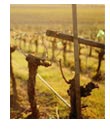 This pruning weakens the vegetative expansion and directs the plant’s resources towards the bunches. This pruning weakens the vegetative expansion and directs the plant’s resources towards the bunches.
Tying is usually done at the same time as pruning and consists of bending and tying up to a prop (usually, a wire) the cane resultant from pruning. The prop supports the grapevine and allows the sap to reach the entire plant. The cane is bended for a good distribution of the grapevine’s leaves.
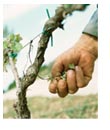 Green interventions are operations performed on the grapevine while it is still in the vegetative process. They are useful to continue assuring the best conditions for the development of the plant and ripening of the bunches. They are also essential for an easy application of plant protection products and easy passage of machines. Important operations are: topping (cutting of the vegetation’s ends); defoliation (cutting of young branches and unnecessary leaves, in order to ease the ripening of the bunches) and bunch thinning (used in very productive grapevines; consists of eliminating some bunches in order to improve the quality of those that remain in the grapevine). Green interventions are operations performed on the grapevine while it is still in the vegetative process. They are useful to continue assuring the best conditions for the development of the plant and ripening of the bunches. They are also essential for an easy application of plant protection products and easy passage of machines. Important operations are: topping (cutting of the vegetation’s ends); defoliation (cutting of young branches and unnecessary leaves, in order to ease the ripening of the bunches) and bunch thinning (used in very productive grapevines; consists of eliminating some bunches in order to improve the quality of those that remain in the grapevine).
 The grapevine is subject to diseases (bacteria, viruses or fungus that attack the plant) or pests (when animals, such as insects or birds, cause damages in the grapevine). Some of the most common diseases in Portugal are the downy and powdery mildew, which attack the green organs of the plant. Some of the most usual pests are the grape berry moth (affects berries in every phase of their development), green leafhopper and red spider mite (cause damage on the foliage). The grapevine is subject to diseases (bacteria, viruses or fungus that attack the plant) or pests (when animals, such as insects or birds, cause damages in the grapevine). Some of the most common diseases in Portugal are the downy and powdery mildew, which attack the green organs of the plant. Some of the most usual pests are the grape berry moth (affects berries in every phase of their development), green leafhopper and red spider mite (cause damage on the foliage).
To avoid diseases and pests, the grapevines receive plant protection treatments that vary not only according to region, soil and planted grape variety, but also in number of sprays and type of fungicide used.
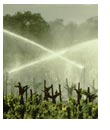 The grapevine needs water at the start of its vegetative growth, i.e., when the berries start growing, and during the ripening phase. However, excessive irrigation may be damaging, since it leads to an abnormal growth of the berries and, consequently, to less concentrated musts. Nowadays, the drip irrigation system is very popular, as it allows controlling the amount of water deposited on each grapevine. However, there are several places where the vines are not regularly irrigated. In fact, what happens in most of the country is that the vines are only irrigated in very hot and dry summers, and where this type of weather is not normal. The grapevine needs water at the start of its vegetative growth, i.e., when the berries start growing, and during the ripening phase. However, excessive irrigation may be damaging, since it leads to an abnormal growth of the berries and, consequently, to less concentrated musts. Nowadays, the drip irrigation system is very popular, as it allows controlling the amount of water deposited on each grapevine. However, there are several places where the vines are not regularly irrigated. In fact, what happens in most of the country is that the vines are only irrigated in very hot and dry summers, and where this type of weather is not normal.
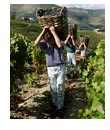 The time for harvesting is determined according to the ripening state of the grapes and the weather conditions. As the bunches ripen, the berries’ acidity decreases and the sugar levels get higher. It is possible to perform sample analyses and, from the acidity and predictable alcohol level, try to determine the time for harvesting. As for weather conditions, it is desirable that it doesn’t rain, since water and moist absorbed by the bunches are passed on to the wine. The time for harvesting is determined according to the ripening state of the grapes and the weather conditions. As the bunches ripen, the berries’ acidity decreases and the sugar levels get higher. It is possible to perform sample analyses and, from the acidity and predictable alcohol level, try to determine the time for harvesting. As for weather conditions, it is desirable that it doesn’t rain, since water and moist absorbed by the bunches are passed on to the wine.
|